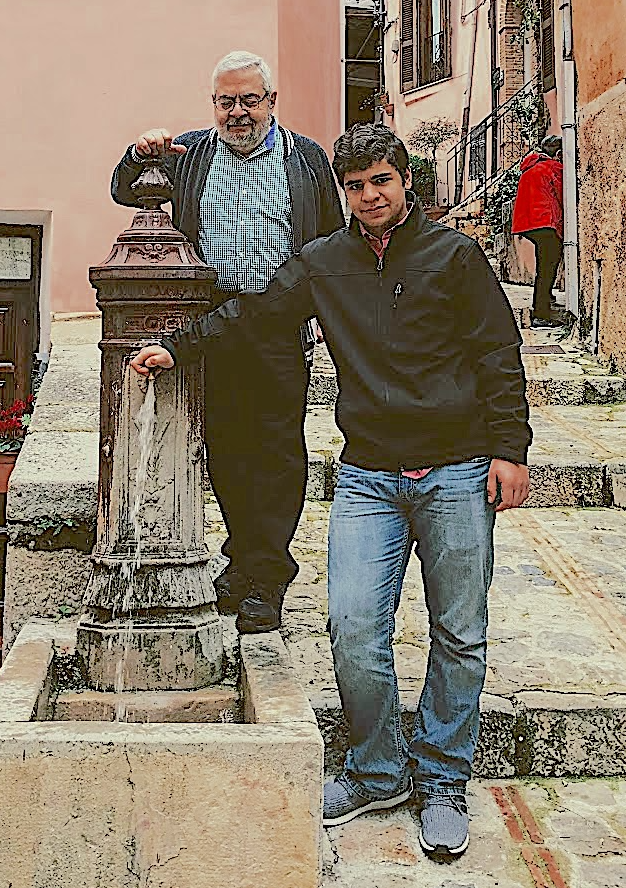
 Terra Oscura is a magical fantasy world of my own creation, and the home of my Creative Soul. It is the fountain of all my creativity and, whenever I'm working on my art, I am THERE in spirit, drinking. At left my grandson and I visit the actual fountain in Monte san Biagio, Italy, where my father got water for his family. Terra Oscura is a reflection of that Italia. Every project that I work on has a specific connection or is inspired by this "Oscure Land", whether it's a clay sculpture or a robot.
Terra Oscura is a magical fantasy world of my own creation, and the home of my Creative Soul. It is the fountain of all my creativity and, whenever I'm working on my art, I am THERE in spirit, drinking. At left my grandson and I visit the actual fountain in Monte san Biagio, Italy, where my father got water for his family. Terra Oscura is a reflection of that Italia. Every project that I work on has a specific connection or is inspired by this "Oscure Land", whether it's a clay sculpture or a robot.
Terra Oscura is very much like our (so-called) “Real” World and, if you visited there, you would not immediately see the differences. However, you would soon notice that this fantasy world is not only inhabited by Humans, but also by Gnomi (Italian gnomes), Trolls, Ogres, Faeries, and other fantasy creatures. All these beings coexist in a state of fragile and tenuous tolerance of each other (most of the time). And, because of the presence of Faerie Folk in Terra Oscura, there is a bit of Magic mixed into the world, along with strange, mystical and spiritual events.
Terra Oscura is geographically centered in an alternate-reality version of Liguria, the Northwestern Italian Provence, with its capital, Quercia (Genova in our “real” world). It exists in a time which includes both the wide use of steam power and other Industrial Revolution technology, and yet also has some very advanced inventions and technology. The final result is an alternative reality, in which Old-World Italy is intertwined with imagined technology and engineering, and includes many types and races of beings, with all the possibilities of magic and fantasy
Quercia (pronounced 'QUERE-chia')
The principle City-State within Terra Oscura
Quercia is a large, bustling seaport, with many industries, warehouses, and their ancillary services clustered (and cluttered) at the water's edge and climbing the lower slopes of the Ligurian Apennine mountains which, in this area, reaches down almost to the shore. Larger ships are constantly embarking or disembarking, loading or unloading at the major wharfs. Meanwhile, various small and large fishing boats compete for a space at the other docks, to deliver their fresh catch to market and to load bait and supplies. Along this waterfront, between the imposing buildings and the docks, runs a main street; the Viadella Marina (street of the sea).
Here, a wondrous variety of street vendors and open markets jostle for an optimal position from which to tout their wares, and one can buy just about everything imaginable. In among these more-or-less “legitimate” stalls and tables, there are a multitude of smaller, less-obvious vendors buying, selling, bartering,and stealing junk jewelry, fast foods, slightly-used clothing, and all the other little necessities of life.
Finally, to add more spice and noise to the scene, there are rampaging ragamuffins and burly stevedores, tired washer-women and elegant courtesans, serious businessmen and crafty pickpockets, crusty sailors and hurried housewives, not to mention all the other people working (or trying to find work) to feed their families and generally just carry on. All of these people are speaking a jumble of French, Italian, and the unique Ligurian dialect of the region but, somehow, they find away to understand each other when absolutely necessary.
The architecture of Quercia has familiar Mediterranean themes, dominated by stone, brick, and stucco, with terracotta tile roofs and heavy metal and wooden accents(doors, shutters, hardware, gutters, etc). Most buildings on the waterfront are large and imposing warehouses and factories; huge and grimy, with large freight doors and loading docks, but few windows. Sprinkled in among these buildings are some fancier banks,stores, and commercial office buildings. Finally, wedged into the remaining little nooks and crannies, there are smaller shops, hotels, trattorias, bars, salumerias, boardinghouses, panerias, bordellos, and tenement buildings.
The majority of the streets are paved, but the side streets and alleyways are remarkably narrow, with surfaces of cobblestones and mud. They are damp, winding, and dark, with a tiny piazza and church around every corner. The dominant power source for factories is still coal-fired steam, although electricity is beginning to take hold here. For trucks, wagons, and railroads internal combustion Benzene (gas) and diesel engines are now becoming established,and powering some wondrous "new-fangled" machines, as well as many light rail androad vehicles.
The dock itself is chock-a-block full of cargo, crates of fish, trucks, coils of rope, barrels of rum or wine, open-air fish market stalls, chain of all sizes, garbage, and cats. The intermixed rotten, sweet, foul, and pungent smells can sometimes, when the breeze calms, make grown men retch and women faint. The cacophony of sounds is painful to the ears; shrieks and moans, raucouslaughter and pitiful crying, angry growls and grumbling, calls for more vino, bells and horns, meows and barks, vendors hawking their wares, and the frequent piercing blasts from a policeman's whistle.
